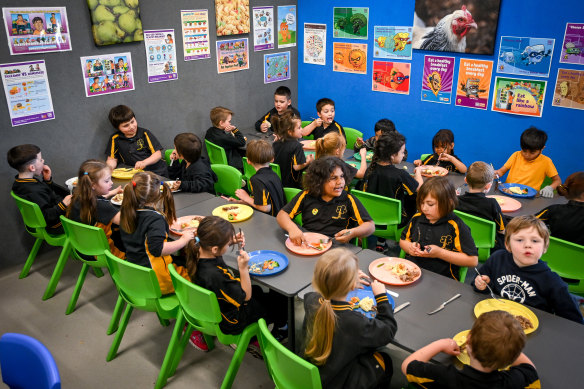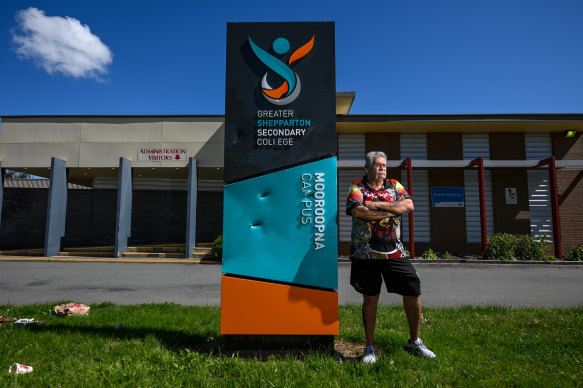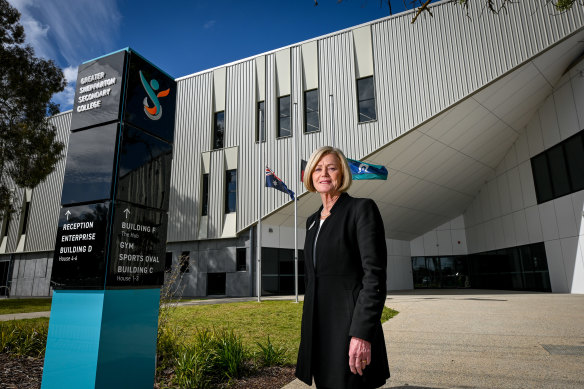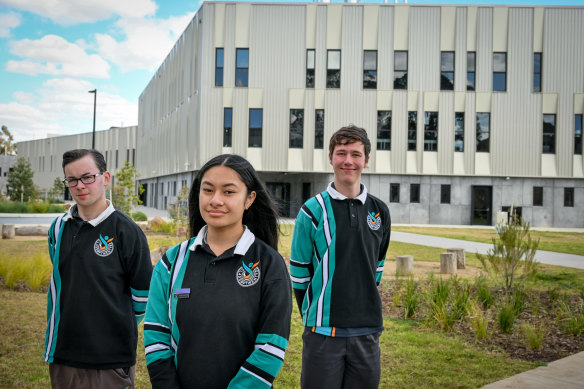By Adam Carey
It’s lunchtime at Mooroopna Park Primary School, and lamb roast is on the menu, with gravy, mash and vegies, chased down by chocolate bliss balls and fresh fruit for dessert.
The school’s compact “cafe” is filled with children seated in long rows, feasting on the free feed.
Hot lunches are served daily at Mooroopna Park Primary, Victoria’s most disadvantaged school.Credit:Eddie Jim
Tania Bryant, the school’s chef, cooks a hot lunch for the school’s entire cohort of 120 students every day, as well as breakfast for 50 or more each morning.
Few schools in Shepparton employ a chef. Mooroopna Park hired one full-time because too many students were coming in each day with no food, or the wrong food, principal Hayden Beaton says. It was affecting their learning and their behaviour.
“Before we started the program lots of kids weren’t bringing lunch, so we were making them sandwiches anyway,” he says. “Parents were dropping in takeaway food or sending them in with bags of chips. What they were eating wasn’t good, so we think we’ve made a massive difference providing that.”
All schools in Australia are scored via a demographic formula called the Index of Community Socio-educational Advantage, and according to that measure, Mooroopna Park Primary is the most disadvantaged school in Victoria.
Most of its parents and carers have limited education and low incomes, and more than half are single parents. Forty per cent of students are Indigenous.
The children have high needs, and the school provides a high level of intervention. Its wellbeing program includes speech therapy, play therapy, eye and ear checks, and regular visits by a paediatrician.
It’s intended not just to get students ready to learn, but to get them through the front gate, Beaton says. Attendance, too often patchy, relies on building connections with parents and carers, many of whom had negative experiences of school themselves. The assistance also extends to helping grade 6 students transition to secondary school.
Until 2020, the process involved visits to the neighbouring school, Mooroopna Secondary College. Head of wellbeing Lisa Hueston would lead the students there for cultural activities such as Koori dancing. It was a way to build trust and foster links, but the college is closed now.
Its buildings are intact, but every door and window is boarded shut. Lawns are overgrown and littered with rubbish from overflowing bins. Security guards patrol the grounds 24 hours a day.
Yorta Yorta elder Les Cowan says Mooroopna lost a critical part of its identity when the secondary school was closed. Credit:Eddie Jim
Yorta Yorta elder Les Cowan went to school in Mooroopna in the 1960s, in what he calls “the bad times”. He recalls having to sit with his back facing the blackboard. “Only the Aboriginal kids; it was hard to learn,” he says.
Cowan didn’t complete primary school, but these days he is president of Ardmona Primary School council, where he drums into the children the importance of being in school.
“I tell the kids, you must go to school, you have to learn,” he says. “Some parents sit at home thinking: ‘Is it worth sending our children to school? We can teach them from home.’ But they don’t learn enough from home.”
Cowan says the town lost more than a school when Mooroopna Secondary College closed. An ecosystem of community commerce and activity is disappearing with it.
“You have a town like Mooroopna which had a big thriving school, now nothing. We’ve now lost the local supermarket down that end of town, the Shell servo. To me, it’s going to be a ghost town very soon.
“We need this school. This is our culture here, this is our town.”
In the 2018 state election campaign, the Andrews government promised to open 100 new schools across the state. Much like its approach to level crossing removals, it busily set about making school-building one of its signature infrastructure legacies.
But Shepparton and its smaller satellite town, Mooroopna, stand alone amid the building blitz as communities where the state closed four schools.
In seeking to fix what it argued was years of stubbornly poor results in Shepparton’s state schools, the Andrews government went about destroying the village to save it.
The regional city’s four state secondary schools, Wanganui Park Secondary College, McGuire College, Shepparton High and Mooroopna Secondary College, were closed between 2020 and 2021 and merged into a new $121 million mega campus called Greater Shepparton Secondary College.
To locals, it is “the super school”, an imposing multi-storey campus on the site of the former Shepparton High, the oldest secondary school in town, which was demolished to make way for it.
The $121 million Greater Shepparton Secondary College “super school” was built on the site of the demolished Shepparton High.Credit:Eddie Jim
The new school is state-of-the-art, with specialist precincts for technology, arts, media and science, competition-sized basketball and netball courts, and even a series of rooftop gardens.
It was built within 18 months, amid multiple COVID-19 lockdowns, a “ridiculously tight timeline”, says Jason Cox, regional manager with builder Hansen Yuncken. “There was some political angst around the project, so it was important for the community to see this delivered on time and have confidence in sending their kids to this school.”
Cox says the new school is “a beacon in Shepparton”.
But the closures of the four old schools are still strongly felt in the community of 68,000 people, many of whom believe the merger was imposed on them.
“We were told that we had four failing schools; that’s an awful thing to tell a community,” says Jenny Houlihan, a former Shepparton mayor with ties to the National Party.
The new school’s early months were blighted by outbursts of violence and racial conflict among its multicultural students, and staff unrest that led to the foundation principal’s premature departure from the role.
And though it was built to be the biggest school in regional Victoria, with capacity for a forecast 2700 students, community reticence meant it began with fewer than 2300 last year, and has shrunk to about 2100 students this year.
Shepparton is not a Labor seat. Until 2014, it had only ever been held by the Nationals, before they lost it to independent Suzanna Sheed.
The Coalition has invested its hopes in regaining the seat on resentment about the super school. Sheed, who is seeking a third term, has been on a unity ticket with Labor in championing the school merger.
‘None of the schools were performing.’
As another election looms, there are separate political and grassroots campaigns to open another state secondary school in the area. Opposition Leader Matthew Guy visited Shepparton last week and promised to build a second school, though the pledge was devoid of any funding or a confirmed site.
Labor’s Education Minister Natalie Hutchins is dismissive. “They want to go back to letting the community down through underfunded and underperforming schools in Shepparton,” she says.
The case for merging the four schools was built on their long-term poor NAPLAN and VCE data.
At three of the four schools, more than 60 per cent of students were in the bottom quartile for VCE results. Less than one in 10 year 9 students at the four schools were in the top two bands of NAPLAN for reading.
“So none of the schools were performing, they were well under what was expected,” says Barbara O’Brien, the new school’s second executive principal and the person entrusted with leading Shepparton’s educational turnaround.
Her family is deeply involved in Shepparton schooling. Her two siblings are principals of local state primary schools.
Greater Shepparton Secondary College principal Barbara O’Brien.Credit:Eddie Jim
O’Brien says it will take time for results to improve. This year’s NAPLAN test, taken when students had been on campus for just four months after two years of disruption, has not yet delivered the desired improvement.
“Students had a number of transitions from one campus to another over those years. It was probably not an ideal time, the two years when we had that transition before we moved here.”
But O’Brien believes the school’s superior facilities and wider subject offerings than the four shuttered schools means the academic improvement will come, as will parental confidence in the school.
Community calls to revive any of the old schools are misguided, she says. “I think that they have got to understand that this school can offer their child so many more opportunities than a small school would be able to offer them.”
Year 12 student Rowan Farren has no nostalgia for the run-down resources of his former school, Wanganui Park College. “It’s a lot more modern,” he says. “Beforehand, we had faulty displays and projectors which were not stable enough to function in every class, internet access which could be dodgy … The facilities are just a lot nicer and a lot cleaner.”
Farren is studying VCE economics this year, a subject that wasn’t even offered at his old school, and plans to begin a Bachelor of Commerce at university next year.
Greater Shepparton Secondary College year 12 students Rowan Farren, Kesalini Muli and Tristan Phipps are embracing the bigger range of subjects at the new school.Credit:Eddie Jim
School music captain Kesalini Muli says racial tensions and fighting that ruined the transition in 2020 and 2021 have settled down since the school launched the “Know Your Roots” diversity education program and employed multicultural aides.
“Especially the teachers are handling it better now,” she says. “There’s little fights here and there, but it’s not as big as last year because we are all changing our ways.”
No one is arguing that results were not poor at the old schools. But former mayor Houlihan, who has been one of the most vocal critics of the closures, says it is unjust to pin poor results on the schools, given the high levels of disadvantage and diversity in the communities they served.
“NAPLAN and VCE scores have got a lot to do with the background of the students,” she argues. “How can a school that has a majority of kids who can’t speak English do well in NAPLAN, compared with the private school down the road with all the white kids? But people seem to think that’s the school’s fault.”
Median household incomes are 20 per cent below the national average in Greater Shepparton, last year’s census found. But despite such high levels of disadvantage in the community, private schools are enjoying boom times, even as public school enrolments languish.
The census revealed that enrolments in the city’s non-government secondary schools have overtaken enrolments in public secondary schools.
Greater Shepparton has shifted from a community with 47 per cent of students in private schools in the 2016 census, to 53 per cent last year.
Dr Lea Campbell, a Melbourne University educator and acting president of public education lobby group Our Children, Our Schools, says poor leadership led the community to lose confidence in the local state school system.
“Anyone that can afford to opt out of public education will,” she says.
Campbell is leading a community campaign to reopen Mooroopna Secondary College. A parliamentary petition she launched this month has collected more than 1000 signatures.
Not all students who have left the public system have gone to private schools. Some have left education altogether.
Jenny Millar watched her son become increasingly disengaged as he went through four “very disruptive” campus changes in four years during the transition. Previously a keen student, in year 8 in 2019 he was part of McGuire College’s select entry advanced learning program “for clever kids”, as his mother puts it.
In 2020, the first year of the transition, Millar’s son was sent to Mooroopna, where he was bullied by two boys and goaded to fight, she says. He lost allies in the schoolyard as some of his friends switched to Notre Dame, the town’s largest Catholic school.
In year 10, sent to Wanganui Park, he lost interest in study, but teachers who didn’t know him well didn’t intervene, Millar says.
“They weren’t picking up on danger signs that he was disengaging, that this is not usual behaviour, that this kid is smart and capable, he’s just lost and not got connections any more.”
This year, midway through year 11 at the new campus, he dropped out of school entirely. He is looking for work, hoping to begin an apprenticeship in construction.
“We just feel like we don’t have a choice,” Millar says. “It’s really difficult because he’s now left mainstream education.”
The Morning Edition newsletter is our guide to the day’s most important and interesting stories, analysis and insights. Sign up here.
Most Viewed in National
Source: Read Full Article







